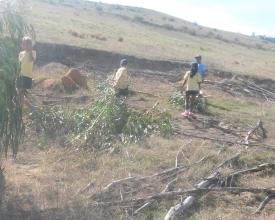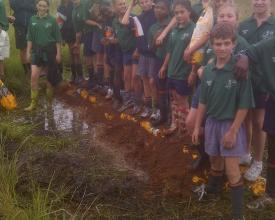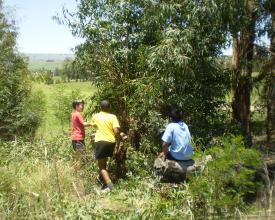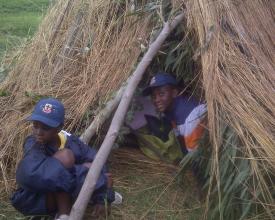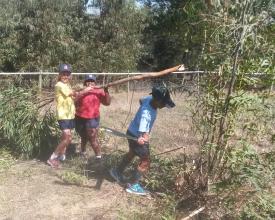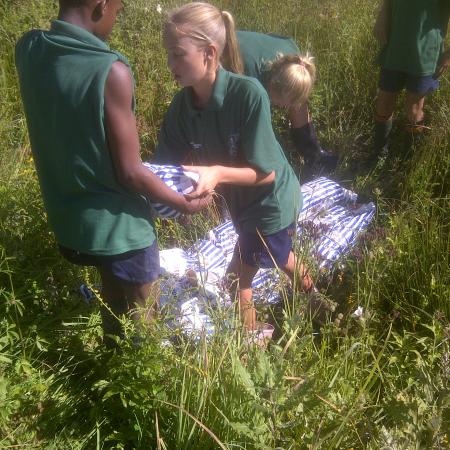
Treverton Wildlife Area - Using education FOR biodiversity to manage a conservation area.
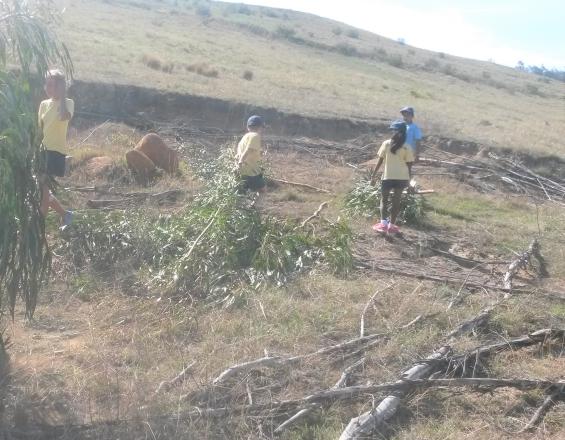
Lack of facilities geared for education FOR biodiversity and outdoor education in protected areas was identified by Treverton, a private education institution, as something to be developed. The Treverton Wildlife Area (TWA) was created as an education resource for protecting a threatened biome. In 1999 negotiations were conducted between the local Agricultural Association and the provincial conservation parastatal organisation for the area, which was previously managed as a cattle farm, to be converted into a conservation biodiversity protected site. After notification to the learners at Treverton and the Department of Education was given, age related programmes were initiated. Learners from Treverton as well as surrounding schools now conduct projects and outdoor education activities either teacher driven or self-motivated under guidance. Education FOR biodiversity and outdoor opportunities are achieved with financial contributions and management.
Contexte
Challenges addressed
The predominate environmental challenges to the area are related to previous management practices. These include; (1) wetland drainage, (2) exotic plants, (3) erosion, (4) poor grassland management, (5) poor cropland development and (6) catchment management. Educational projects have been developed to assist with the rehabilitation of these issues. This, however, does form important educational opportunities (for which the area was developed). As the only income from the area is restricted to the sale of excess game stock, the management and rehabilitation costs are covered by the educational institution. However, as the school places significance on the area and the concept is incorporated in the focus of the school, sustainability is confirmed but with limited funds. Treverton Widlife Area has received recognition from the community. However, it does receive pressure for utilisation for non-conservation related activities, which have to be monitored for the benefit of all.
Emplacement
Traiter
Summary of the process
Quality education should include Evaluative Competence in Reflexive Learning. By developing projects which allow for Tune-in (planning together), Talk (dialogue), Think (reflect and revise), Touch (fieldwork encounters) and Taking action allows for the educational processes which are not only OF biodiversity but also FOR biodiversity. These activities/actions/encounters are outdoor education for biodiversity and for protected areas while being of significance and important to the individuals’ personal development and being. Going through the process and solutions to get the TWA developed allowed for the facility which supplied the opportunities for the education for biodiversity. Conducting Education FOR Biodiversity projects allowed for quality education while outdoors. However, Outdoor Education is not only limited to education for biodiversity but also incorporates other components which are conducted in the biodiversity area. The better the biodiversity within the area the greater the opportunities for outdoor education
Building Blocks
Education FOR Biodiversity (Action Learning)
The Treverton Wildlife Area was developed as an educational facility. Action Learning, Learning by Doing, Outdoor Education and Capacity Building educational processes where implemented to develop a biodiversity improved and enriched area. The facility allowed/allows learners to participate directly with the environmental projects ‘at home’ with projects for biodiversity.
Learners actively conduct action learning projects which are either teacher driven (lower grades) or learner driven (higher grades) or a combination thereof to perform specific outcomes related to biodiversity rehabilitation. The projects are conducted under guidance with the emphasis being on education processes, youth empowerment and capacity building. The improved biodiversity is not the primary motivation for the activities but rather an outcomes.
Outdoor Education programmes are conducted in the TWA with the purpose of individual growth, environmental interaction, mental health, outdoor skills, improve communication and decrease stress levels.
Capacity Building projects are conducted with educators in the region. The teachers participate in activities within skills development courses related to biodiversity. Teachers are then able to implement these activities with their own learners and in their areas.
Enabling factors
The Treverton management team's acceptance of the concept, their motivation and having the vision to implement the programme. This includes allocation of funds to the programme.
Obtaining support from the educators who see the potential and the importance of conducting educational activities which benefit the long-term biodiversity objectives while supporting good education.
Support from the local community, including the farmers, which encourages the process and contribute to the development in a variety of means (including donations).
Lesson learned
The motivation for the implementation of projects is very important but not always understood by those who are not directly involved in either conservation or environmental education. That is, it is important to attempt to describe: the logic behind the concept, the advantages, the educational outputs and benefits, the proposed processes, the long-term conservation benefits, the methods to be implemented and the educational benefits. However, the bottom line of financial implications or benefits is often still the driving factor. Thus working on these factors and emphasising the social components does have an impact.
The development of educational activities which are related to the curriculum requirements which can be presented to the teachers with the teaching strategies can help the teachers to participate more readily for the first time. Once a teacher has conducted one educational process in the conservation area, he/she is more likely develop future projects. Suggestions of possible projects also encourages the teachers.
Outdoor Education Opportunities
One of the focus points for the development of the Treverton Wildlife Area was to create opportunities for Outdoor Education. More and more research is pointing to the requirements to create opportunities for children, youth and adults to experience the outdoors. Focusing on the benefits to the people improves the motivation for the participation. Understanding the psychological, social, education and physical benefits of outdoor education to individuals allows for greater involvement and increased utilization by educators and the educational institution. The outdoor education facility allowed for the outdoor activities to be conducted (camping, hiking, picnicking, action based projects, exercising, educational projects, solitaire, etc.). These outdoor educational opportunities, activities and projects were and are not the only outcomes achieved. The outdoor education projects are planned with the specific intension of either improving the biodiversity or at the least not impacting on the biodiversity.
Enabling factors
Explanations, backed with research findings, of the significant benefits of outdoor events, projects and activities encourages participation which in-turn facilitates the biodiversity related projects. It is imperative that appropriate planning prior to an event or educational programme is conducted. This must include a risk analysis and procedures. Information on these should be fed to the participants. The more a programme/project is conducted the more the project can be duplicated for the benefit of biodiversity.
Lesson learned
It takes time for some people in the 'chain' to comprehend the concepts presented and to understand the advantages of Outdoor Education projects. For example, understanding how the outdoor activities have significant benefit to individuals who can then have an impact on the biodiversity by conducting specific projects in the protected area.
Once one leader in a community of practice 'buys' into the concept, others will follow. Once a project has been conducted and the advantages 'advertised' to others then the knock-on benefit is seen when the next project is developed. Reducing the barriers to participation is important. This might include time allocation to the projects, transport availability and extra adult supervision where required. Conducting a comprehensive Activity Risk Assessment and development of Protocols with Control Measures for Outdoor Education projects assists with the planning process removing some of the barriers to having learners participate in activities outdoors.
Impacts
The TWA is utilised for education FOR biodiversity by: (1) schools in the educational circuit, (2) conservation students at tertiary level to conduct practical components of their studies, (3) recreational for the community (at no charge), (3) education field trips for Educators' Skills Development and (4) Outdoor Education challenges. Thus addressing an educational requirement which was previously not incorporated. Education FOR Biodiversity projects conducted included the reintroduction of natural species. Wetland rehabilitation, where learners physically block drains (an annual project). Appropriate grassland management has had significant impact and improvement on the biodiversity. Projects like exotic plant control and erosion control (conducted by learners) have visual results. The biodiversity improved to the extent where the provincial conservation organisation (Ezemvelo KZN Wildlife) awarded the Site of Conservation Significance in 2005. Outdoor Education programmes in a safe environment and close to the support base have increased due to the TWA facility. The concept of education leading the way FOR protected areas development and management has been seen as unique and was an indication for other education institutions to adopt. Since its development other educational institutions have developed similar conservation sites.
Beneficiaries
Learners from schools in the region, environmental management students and educators participate in educational projects on the TWA. Outdoor Education activities are conducted in the area, e.g. cross country, hiking, camping, nature walks, etc.
Sustainable Development Goals
Story

A 15ha wetland is included in the Treverton Wildlife Area (TWA). Unfortunately, this wetland was drained in past, inappropriate, agricultural management. The drains have had a significant effect on the water retention, flood control, basic biodiversity and invasive plants in the wetland. An organisation which specialised in wetlands and the rehabilitation thereof was requested to conduct a survey of the area and to supply advice on appropriate rehabilitation processes to be implemented. In the 1990s an Educational FOR Biodiversity project was initiated whereby learners from Treverton, at a specific grade level, started to physically rehabilitate the wetland. Since inception, each year learners from Grade 7 have participated in the project. Wetland studies forms part of their Environmental Education subject for that year. Prior to the rehabilitation process the learners receive content knowledge based lessons and they produce assignments specifically relating to the importance of wetlands. Their participatory education involves the physical aspect of rehabilitation. Learners then spend time in the wetland, physically building blocks in the drains and removing the material piled on the sides of the drains. Initially the project included using machinery but once the area retained more water, the use of the machines would have caused damage. This required that the project protocols were rethought. An innovative process was adopted, where learners filled biodegradable bags with soil. Learners were then able to carry the bags to the drains and ‘build walls’ in the drains. The impact on this project is visible in the wetland but also has significant educational benefits. The learners are practically participating, and can see the outcomes of their efforts, having experienced first-hand the effects of the degraded wetland. A good example of experiential learning for the benefit of conservation and biodiversity.
